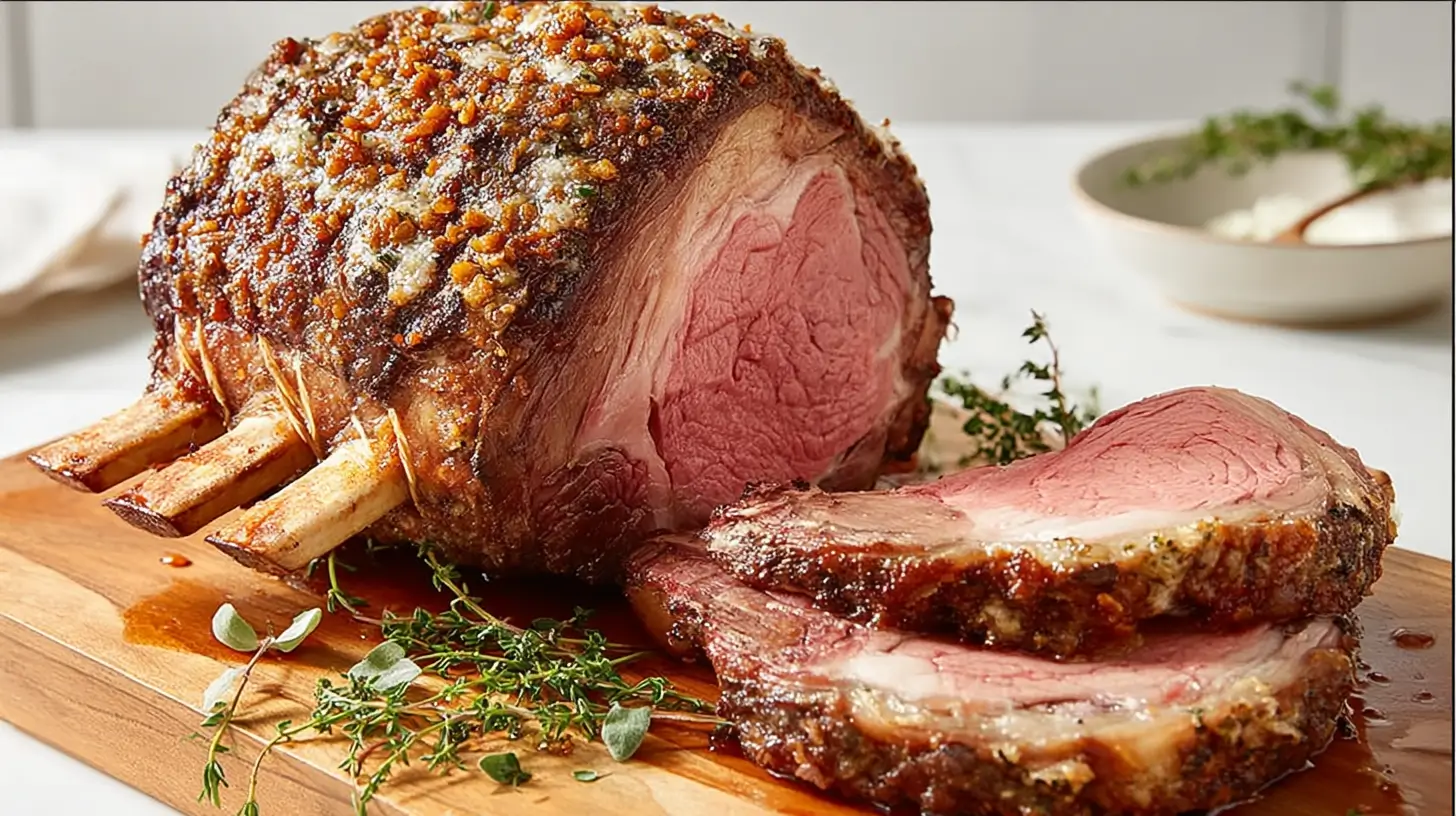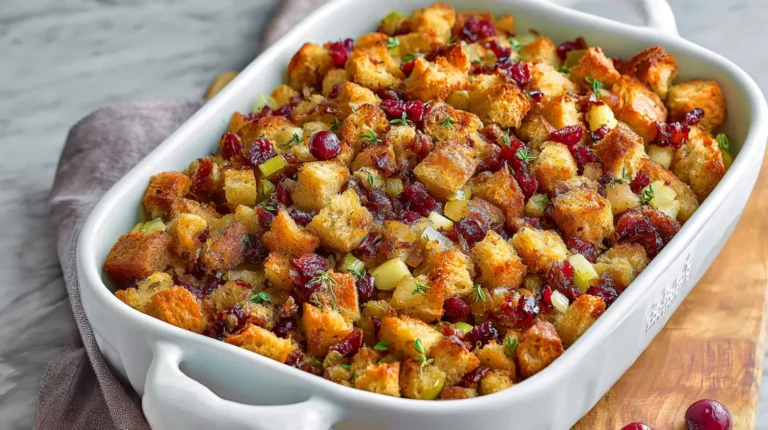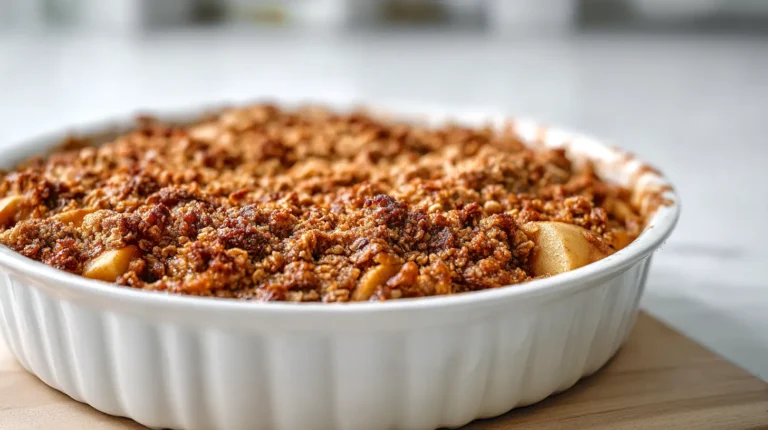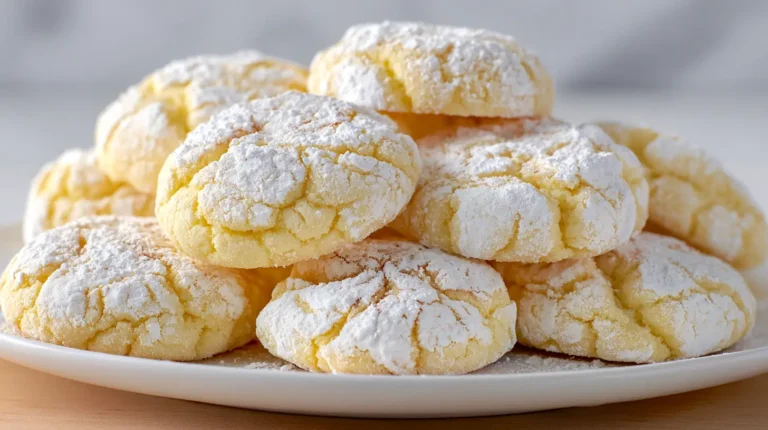There’s something about the holidays that makes me crave a big, impressive roast. Not the kind that feels fussy or out of reach, but one that makes the whole house smell like winter in the best possible way. For me, that dish is chestnut prime rib.
Now, before you roll your eyes and picture some overly complicated chef’s table moment, let me say this: chestnut prime rib isn’t about fancy techniques. It’s about smart layering of flavor, done in a way that feels like wrapping a classic in a cozy sweater. That’s why I lean into a chestnut and herb rub. Roasted chestnuts get blended with thyme, sage, garlic, and butter until they form a paste. That paste gets tucked under the fat cap, and the magic happens right there in the oven. The chestnuts bring this nutty, earthy depth, while the herbs sneak in that forest-fresh aroma.
I’ve found that prime rib is already pretty forgiving if you treat it with respect. Salt it well, give it time, and let the oven do its job. Adding chestnuts doesn’t complicate things—it just elevates it in this warm, seasonal way. Think of it like adding a cashmere scarf to your favorite coat. It’s still the same coat, but now it looks and feels special.
Living in the Southeast, I get picky about what feels truly seasonal, and this chestnut prime rib delivers that winter vibe without question. This roast is all about that balance of tradition and surprise. It screams winter, it fits the season, and it turns an already stunning centerpiece into something unforgettable.
So, let’s break it down. I’ll walk you through ingredients, prep, rub, roasting, resting, and serving. And yes, I’ve got all the step-by-step details covered.
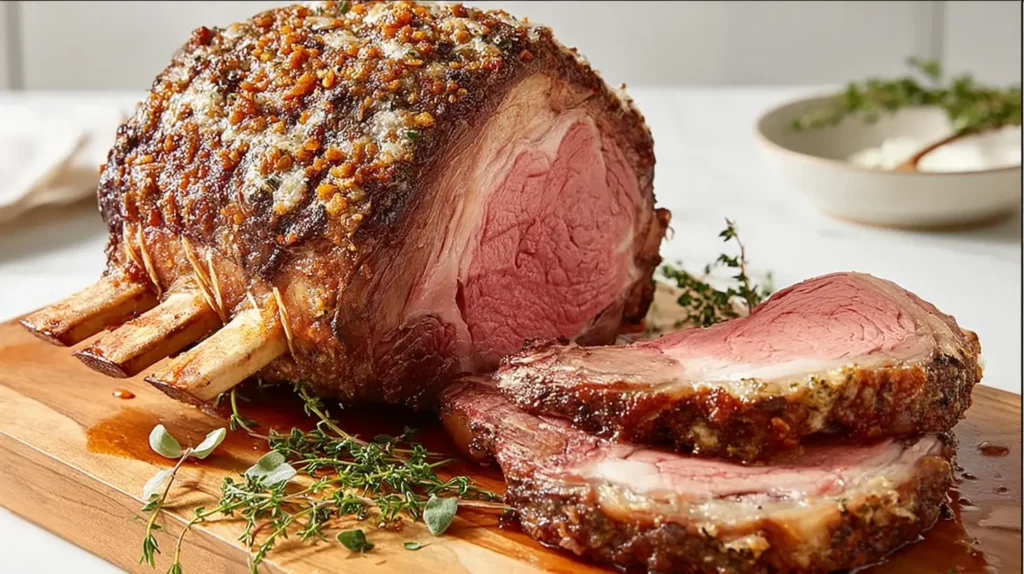
Some of the links here are affiliate links, which is just a fancy way of saying if you click and buy, I may earn a tiny commission. Don’t worry though—it never costs you extra. You can peek at my full disclosure if you’re curious about the fine print.
Choosing the Right Prime Rib
The cut matters more than people like to admit. Prime rib sounds intimidating, but it’s really just a standing rib roast. You’ll see it labeled as bone-in rib roast or sometimes even “export rib.” The bone-in version delivers extra flavor and insulation, keeping the meat juicy.
When I buy one, I aim for three ribs if I’m feeding six to eight people. That gives you heft without battling a giant slab that barely fits in the oven. Figure about one pound per person when you’re calculating.
Look for marbling. That fat weaves through the meat like little rivers, and it melts into tenderness as it cooks. Skip anything that looks lean. This isn’t the place to be frugal on fat content. The fat cap on top? Don’t trim it off. You’ll need it to trap the chestnut and herb rub underneath.
If you’re worried about cost, know that this is a splurge cut. I treat it as the main event, and everything else on the table supports it. Side dishes can stay simple because the roast will take center stage.
One tip I’ve learned: ask the butcher to cut the bones off and then tie them back on. It makes carving so much easier later, but you still get that bone-in flavor. Most butchers do this without blinking.
Once you have the roast, you want to bring it to room temperature before cooking. Cold meat straight from the fridge resists even roasting. Let it sit on the counter for at least two hours. This makes the whole process smoother, and the end result more consistent.
The chestnut prime rib deserves that bit of prep. Starting with the right cut sets you up for success.
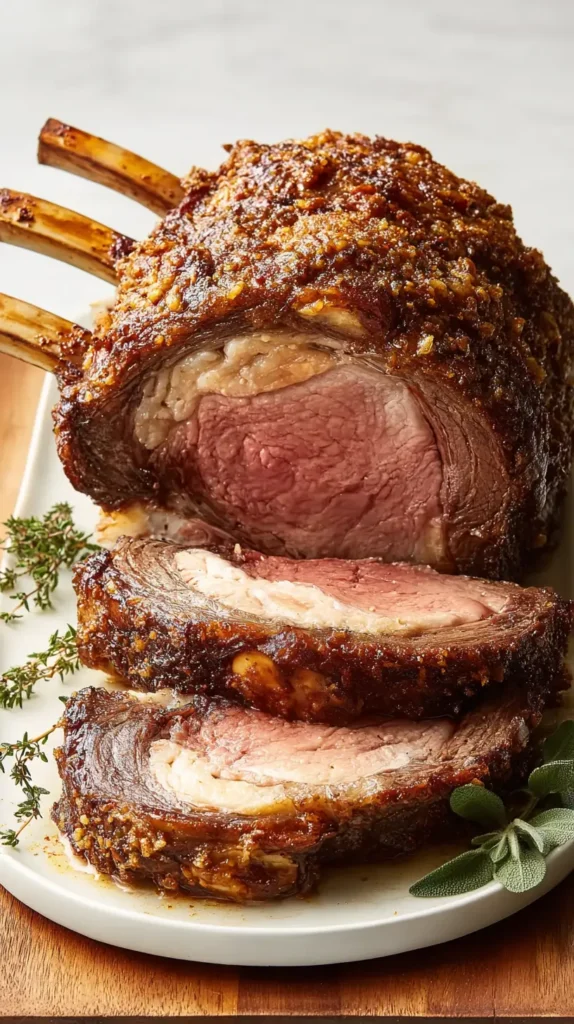
Making the Chestnut and Herb Paste
This is where the magic lives. The chestnut and herb paste is the secret that transforms the roast. Without it, you have a good prime rib. With it, you have something that feels truly seasonal.
Start with roasted chestnuts. You can buy them pre-roasted and peeled, which saves time, or roast your own. If you go the DIY route, score the shells, roast at 425°F for 20 minutes, then peel while warm. You’ll need about 1 ½ cups.
Into the food processor they go. Add one stick of softened unsalted butter. Toss in four cloves of garlic, a tablespoon each of fresh thyme leaves and chopped sage, plus two teaspoons of salt and one teaspoon of black pepper.
Pulse until the mixture looks like a thick, spreadable paste. It should be rustic, not silky smooth. You want those chestnut bits to cling and create texture.
This paste has three jobs. First, it seasons the meat. Second, it creates a crust under the fat cap that bastes the roast as it cooks. Third, it adds that nutty, earthy layer that makes chestnut prime rib so distinctive.
I always sneak in a little lemon zest, maybe half a teaspoon. It’s not traditional, but it brightens the richness. That zing keeps the roast from feeling heavy, even when it’s indulgent.
Once your paste is ready, stash it in the fridge if you’re prepping ahead. It firms up nicely and spreads easier when slightly chilled. But don’t worry, it melts right into the meat as soon as heat hits it.
This chestnut blend becomes the heartbeat of the dish. Without it, you’ve got steakhouse. With it, you’ve got winter wrapped in flavor.
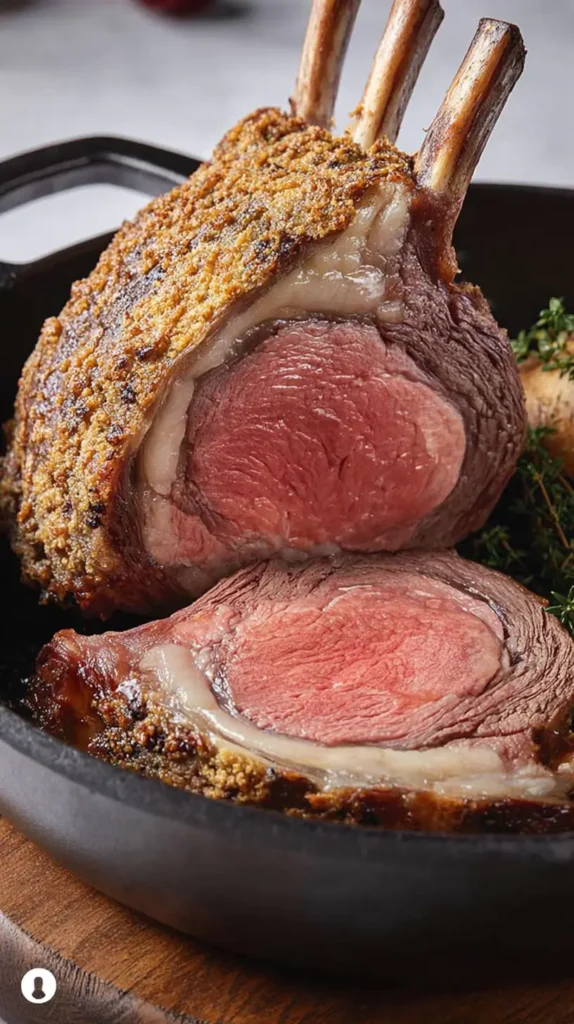
Applying the Rub Under the Fat Cap
Here’s the part that feels fancy but really isn’t. You’re going to lift the fat cap and tuck the chestnut paste underneath. Think of it like slipping a secret note into a pocket.
First, place the roast on a cutting board fat side up. Take a sharp knife and gently loosen one side of the fat cap. Don’t slice it off—just create a flap. You want it still attached so it acts like a lid. Work your fingers under the fat, slowly separating it from the meat.
Once you’ve made space, grab your chestnut paste. Use your hands, not a spoon. This is a messy job, but trust me, hands spread it better. Press the paste evenly across the surface of the meat, getting all the way to the edges.
Pull the fat cap back into place. Press it down so it seals in the paste. The fat acts like insulation, locking everything in. As the roast cooks, the butter and herbs melt into the beef, while the chestnuts create that nutty crust.
Season the outside of the fat cap too. Don’t stop with just what’s inside. Sprinkle generously with kosher salt and cracked pepper. That outer layer will crisp up beautifully.
It may feel odd to fuss with the fat cap, but it’s worth every second. The difference is striking. The paste doesn’t burn, it doesn’t fall off, and it stays where it should.
Every bite of chestnut prime rib comes with this whisper of nut and herb. It feels intentional, almost like the beef was born to taste this way. Once you do it once, you’ll never go back to plain rubs again.
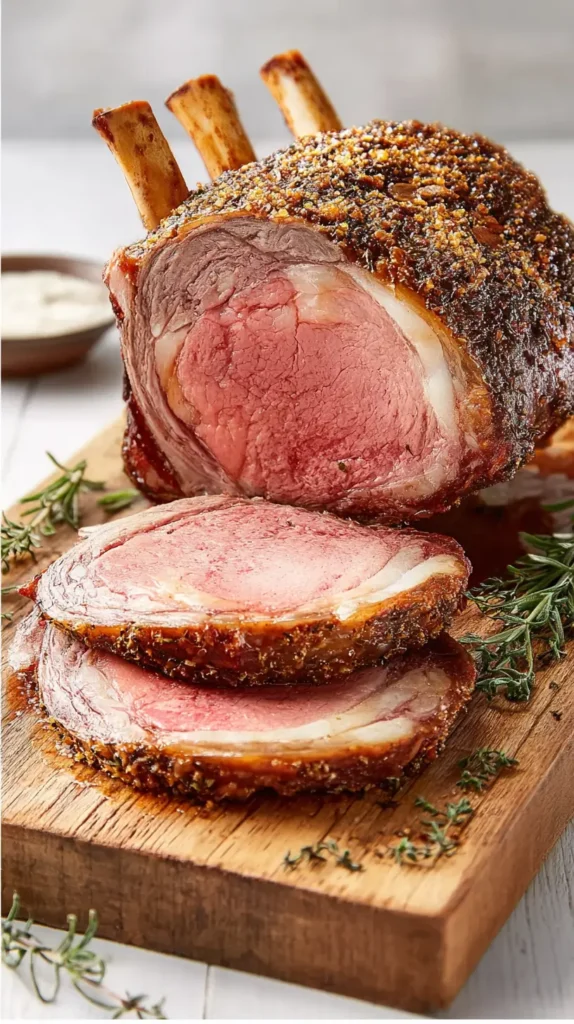
Roasting for Perfect Results
Cooking prime rib is all about patience and precision. Rushing it is the fastest way to ruin it.
Preheat the oven to 500°F. Yes, that sounds aggressive, but you’ll only keep it there for the first 15 minutes. This high heat jumpstarts the crust.
Set the roast bone-side down in a roasting pan with a rack. This keeps the meat elevated, so air circulates and cooks it evenly.
Roast at 500°F for 15 minutes, then drop the temperature to 325°F. From there, it’s about 15 minutes per pound for medium-rare. Always check with a meat thermometer. You want 120°F in the thickest part. It will climb to 130°F while resting.
Don’t skip the thermometer. Guessing is what leaves you with dry meat or a too-raw center.
Tent the roast loosely with foil if the crust looks too dark. The chestnut paste has butter, and butter browns fast. A little foil prevents burning without ruining the finish.
Once it hits temp, pull it from the oven. This is where most people panic and cut too soon. Don’t. Rest it for at least 30 minutes. Resting lets juices settle back into the meat, instead of spilling all over the cutting board.
While it rests, the kitchen smells outrageous. Chestnut prime rib perfumes the air with herbs and roast beef aroma. It’s the kind of smell that draws people in before you even call them.
By the time you slice, the meat is tender, the crust is golden, and the chestnuts have melted into something almost caramelized. It’s pure satisfaction.
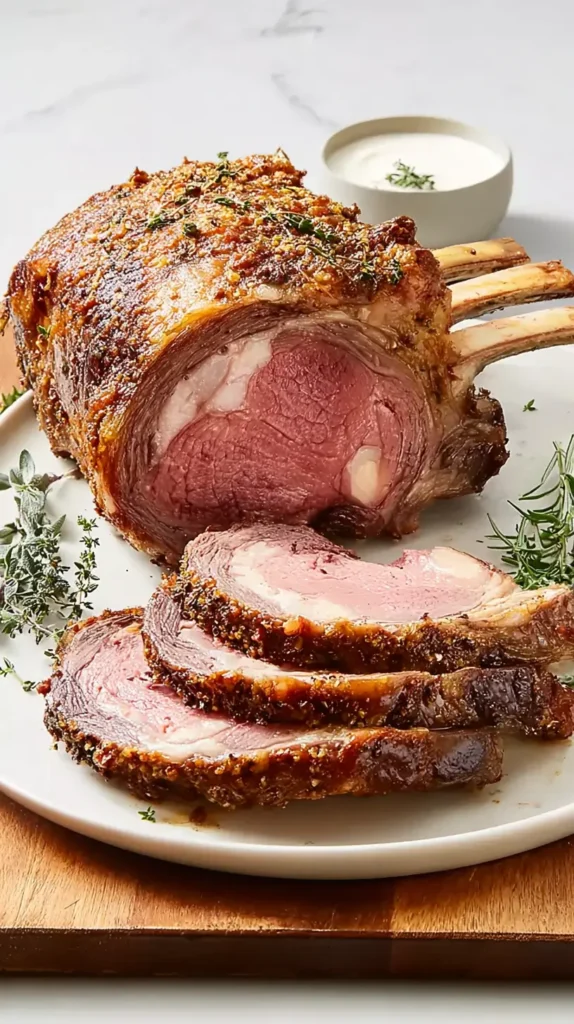
Carving and Serving the Chestnut Prime Rib Roast
Carving prime rib feels like a performance, but it’s easier than it looks. Remember that butcher tip about having the bones cut and tied back on? This is where it pays off.
First, snip the kitchen twine and lift the rib bones right off. They come away as one big slab, leaving the roast boneless and easy to slice.
Set the meat cut-side down. With a long carving knife, slice across the grain into half-inch to one-inch slices. Go thinner if you want elegant, thicker if you want hearty.
The chestnut and herb rub creates a gorgeous crust. You’ll see it as soon as you slice through. That edge of nut, butter, and herbs clings to each piece, making every slice as beautiful as it is flavorful.
Arrange slices on a platter, slightly fanned out. Pour any pan juices into a small bowl to serve alongside. That’s liquid gold.
What do you serve with chestnut prime rib? Keep it seasonal and simple. Roasted root vegetables, creamy mashed potatoes, or even a crisp winter salad. Yorkshire pudding is traditional, but I think crusty bread works just as well.
For presentation, sprinkle a little fresh thyme or rosemary on top. It’s not just garnish—it ties back to the herbs inside the rub.
Leftovers? They make the best sandwiches. Layer slices with horseradish cream on crusty rolls, and you’ve got yourself another meal worth celebrating.
The serving moment always brings gasps. It looks regal, it smells like winter, and it tastes even better. Chestnut prime rib isn’t just food—it’s an event on a platter.
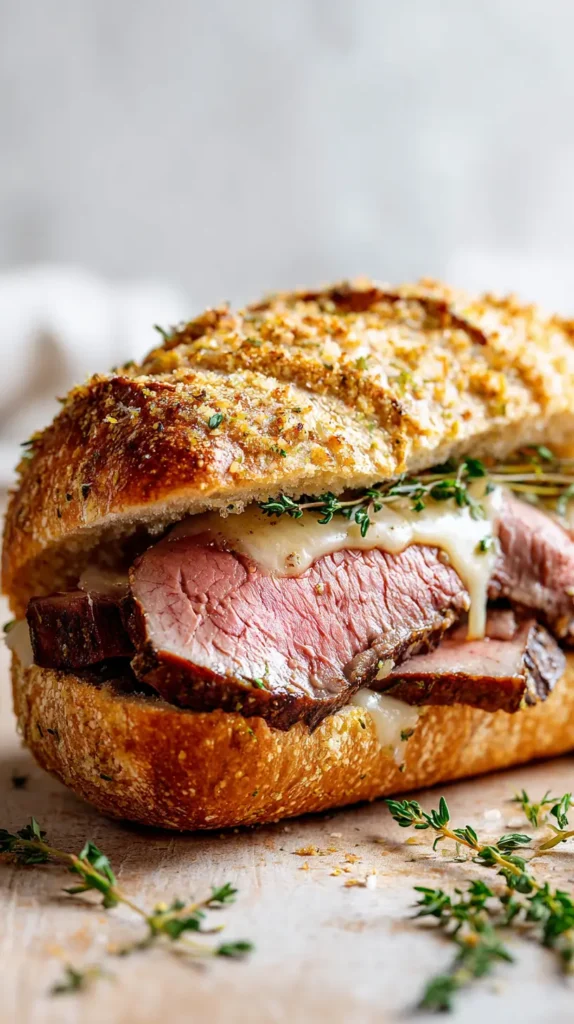
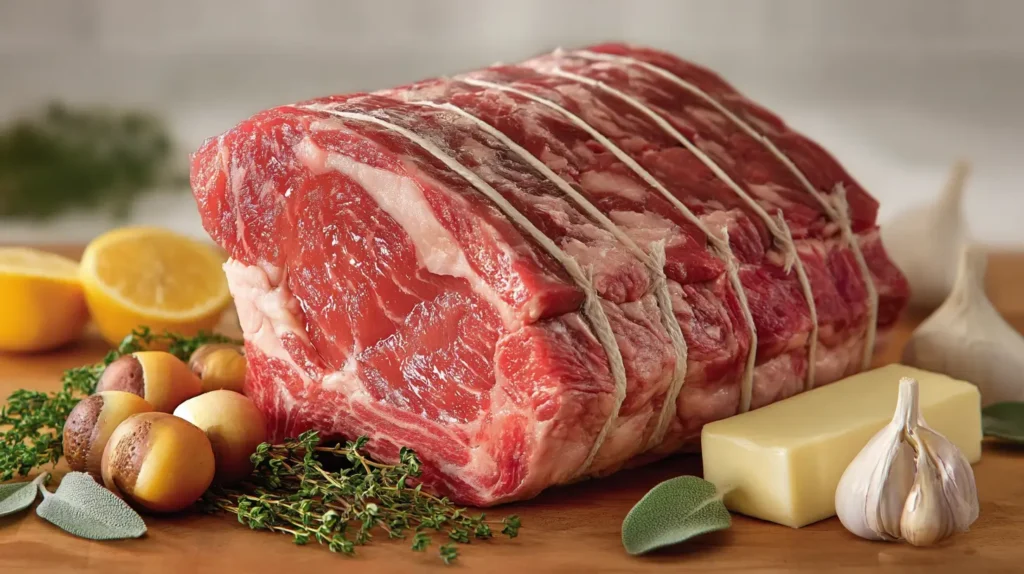
Full Recipe: Chestnut Prime Rib With Herb Rub
Servings: 6–8
Prep Time: 30 minutes
Cook Time: 2–3 hours (depending on size)
Rest Time: 30 minutes
Two-sentence teaser: This chestnut prime rib is roasted to perfection with a chestnut and herb paste tucked under the fat cap. Nutty, earthy, and deeply savory, it’s the ultimate winter centerpiece.
Ingredients:
1 standing rib roast, 6–8 pounds (3 ribs, bone-in, bones cut and tied back)
1 ½ cups roasted chestnuts, peeled
1 stick (½ cup) unsalted butter, softened
4 garlic cloves, peeled
1 tablespoon fresh thyme leaves
1 tablespoon chopped fresh sage
½ teaspoon lemon zest (optional)
2 teaspoons kosher salt (plus more for seasoning outside)
1 teaspoon black pepper (plus more for seasoning outside)
Instructions:
- Preheat oven to 500°F.
- Place roasted chestnuts, butter, garlic, thyme, sage, lemon zest, 2 teaspoons salt, and 1 teaspoon pepper in a food processor. Blend until paste forms.
- Place rib roast fat side up on cutting board. Loosen fat cap with a sharp knife, leaving one side attached.
- Spread chestnut paste evenly under the fat cap with hands. Press fat back into place.
- Season outside of roast generously with kosher salt and black pepper.
- Place roast bone-side down on a rack in a roasting pan.
- Roast at 500°F for 15 minutes.
- Reduce oven temperature to 325°F. Continue roasting about 15 minutes per pound, until thermometer reads 120°F in thickest part.
- Tent loosely with foil if crust darkens too quickly.
- Remove roast from oven. Rest 30 minutes before carving.
- Cut twine, remove rib bones, and slice meat across the grain into desired thickness.
- Serve with pan juices and seasonal sides.
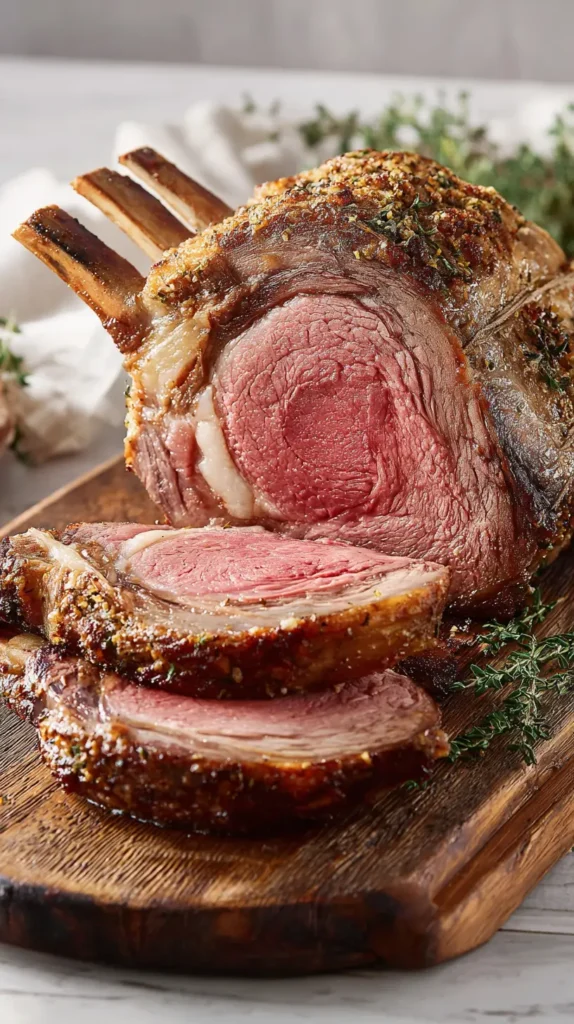
Final Thoughts
When I think about winter dinners that feel both celebratory and comforting, this roast lands at the top of the list. It takes something classic, dresses it up in a seasonal twist, and turns dinner into an occasion. That’s what I love most about cooking: the way food can feel familiar and surprising all at once.
I’ve found that chestnuts are an underrated ingredient. Most people only think of them as a sweet holiday snack, but they shine when you pair them with something savory. This rub proves that. The chestnut prime rib takes that cozy, nutty flavor and fuses it with beef in the most satisfying way. It feels both rustic and elevated, which is exactly the sweet spot for holiday food.
What makes this dish even more rewarding is how simple it is once you understand the steps. There’s no juggling pans or rushing between timers. It’s slow, steady, and forgiving. You get time to enjoy the company around you, which is really the point of a big meal anyway.
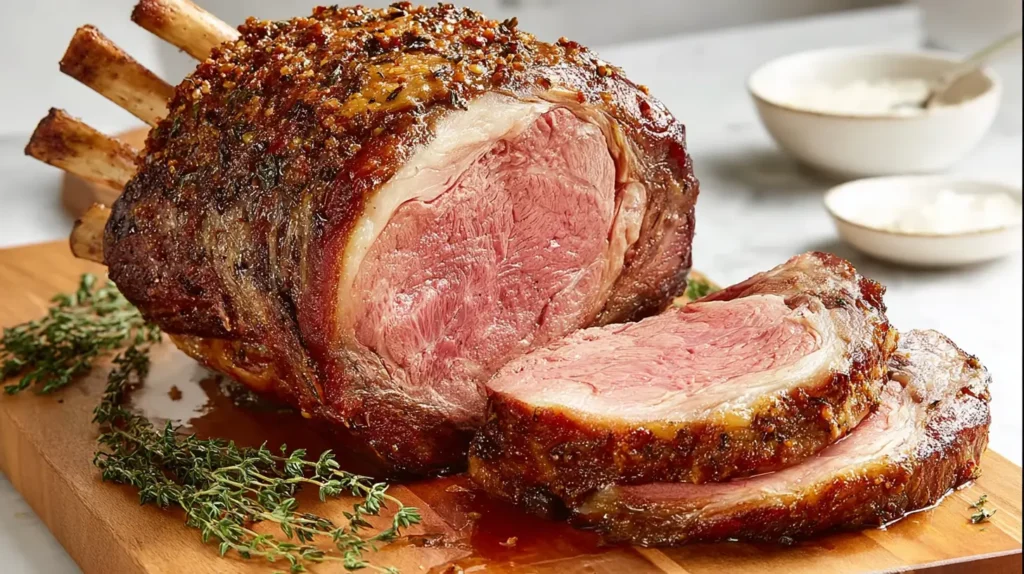
I also love that it photographs beautifully. If you’re like me and you enjoy scrolling Pinterest for ideas, you’ll notice that roasts often look intimidating. This one isn’t. The crust is dramatic, the slices are juicy, and the presentation does half the work. It’s the kind of dish that makes the table glow. I love when a dish leans obviously seasonal, and this roast has that cozy, cold-weather payoff I always crave.
So whether you’re hosting a holiday crowd or just want to treat yourself to something special, this recipe belongs in your lineup. It’s rich, it’s cozy, and it leaves an impression that lingers long after the last bite. And that, to me, is the perfect definition of seasonal crave-worthy food.
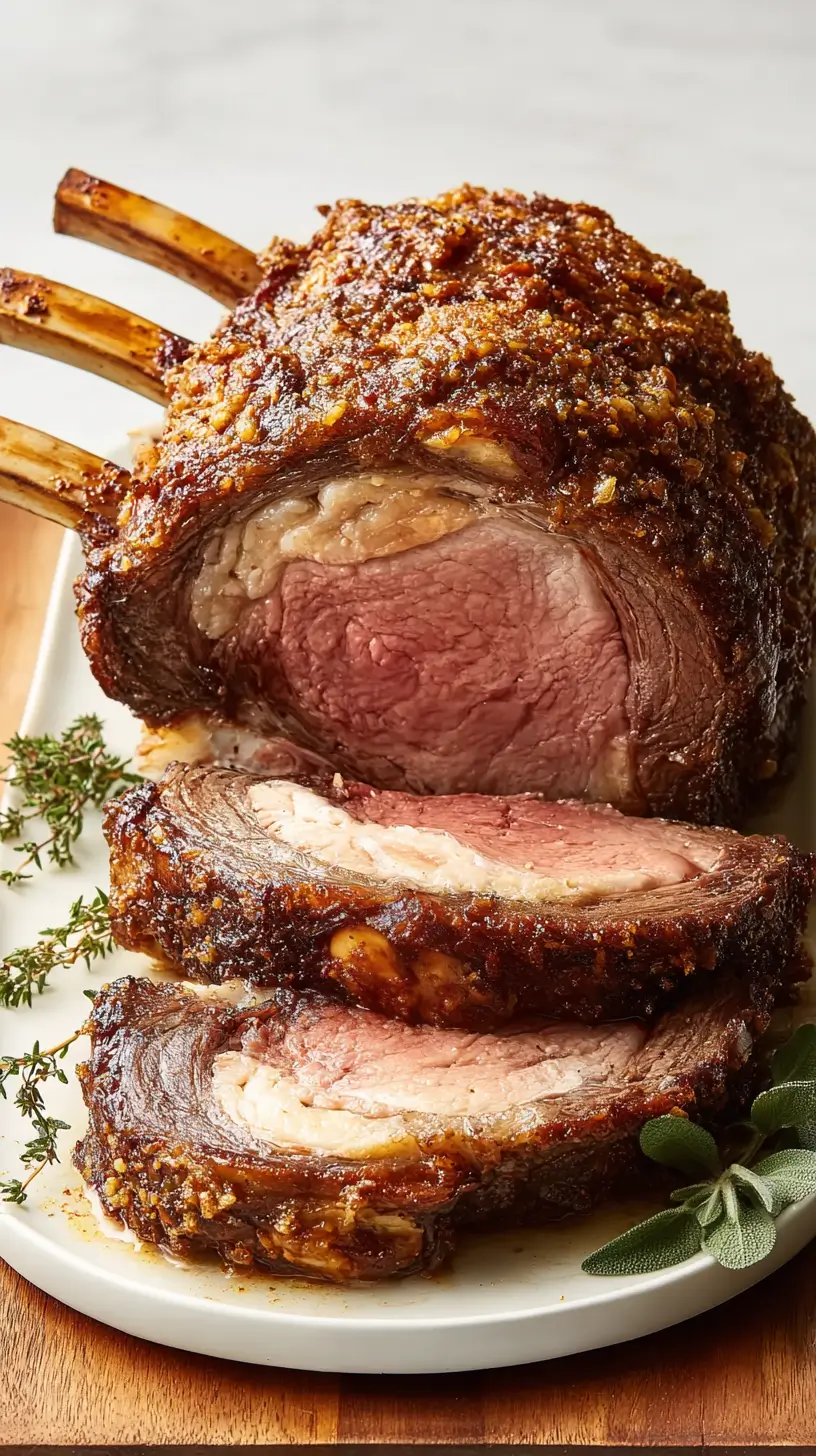
Chestnut Prime Rib with Herb Rub
Ingredients
Method
- Preheat oven to 500°F.
- Place roasted chestnuts, butter, garlic, thyme, sage, lemon zest, 2 teaspoons salt, and 1 teaspoon pepper in a food processor.
- Blend until paste forms.
- Place rib roast fat side up on cutting board.
- Loosen fat cap with a sharp knife, leaving one side attached.
- Spread chestnut paste evenly under the fat cap with hands.
- Press fat back into place.
- Season outside of roast generously with kosher salt and black pepper.
- Place roast bone-side down on a rack in a roasting pan.
- Roast at 500°F for 15 minutes.
- Reduce oven temperature to 325°F.
- Continue roasting about 15 minutes per pound, until thermometer reads 120°F in thickest part.
- Tent loosely with foil if crust darkens too quickly.
- Remove roast from oven.
- Rest 30 minutes before carving.
- Cut twine, remove rib bones, and slice meat across the grain into desired thickness.
- Serve with pan juices and seasonal sides.

